Italy: Endangered sedge is treated to a new home
31.08.10
An endangered sedge, found in Europe in only two sites in southern Italy, has benefitted from a multi-faceted conservation project carried out by Rome Botanical Garden, the Italian Institute for Environmental Protection and Research (ISPRA) and the Regional Body for Protected Areas (RomaNatura).
Cyperus polystachyus is found on Ischia Island, in the Campania region, and in Tor Caldara, in the Lazio Region. These extant locations are notable for the presence of sulphur waters, suggesting this plant is a thermophilous relict in Europe. The Tor Caldara Regional Reserve site is an isolated island of vegetation, according to the authors, and so the the plant's expansion is greatly limited by nearby "wet" sites to spread to as it is surrounded on all sides by human settlements, crop fields, and the sea on the west.
Facing such diverse threats the plant is listed as critically endangered (CR) on the IUCN Red List for Italy, meaning it is facing an extremely high risk of extinction in the wild.
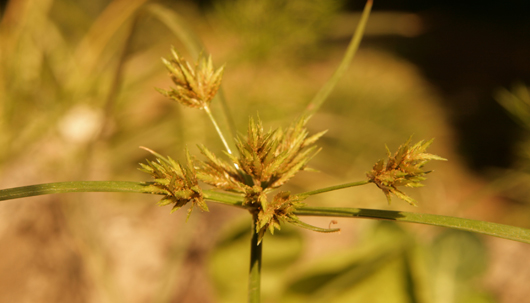
Cyperus polystachyus is possibly a thermophilous relict in Italy
The sedge is endangered at both its sites, with threats coming largely from tourism and water infrastructure developments. These recent changes compound the problems caused by the massive wetland drainage programme (Bonifiche) that has been occurring in southern Italy since the late 1700s. It is very likely this drainage affected the ancient populations of the plant - marshlands once spread throughout the mainland between Ischia and Tor Caldara - but the plant was only identified in Europe in 1802, so there are no records of older distributions.
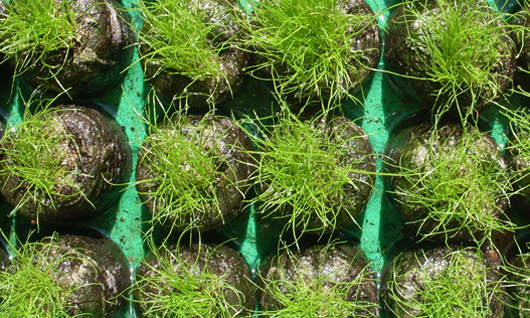
Cyperus polystachyus seedlings awaiting planting
To combat these significant problems an integrated conservation project was initiated involving in situ and ex situ elements. The primary goal being in situ conservation of species and habitat, complemented by ex situ conservation in Rome Botanical Gardens and an experimental translocation experiment to form a new population.
Germplasm (seeds and seedlings) was translocated to a new site in a Protected Area near one of the population sites, and importantly, within the identified dispersal range. New plant establishment in the wild was considered vital for the conservation of the species because its life cycle, distribution and recruitment characteristics make the species particularly vulnerable to changing environmental factors.
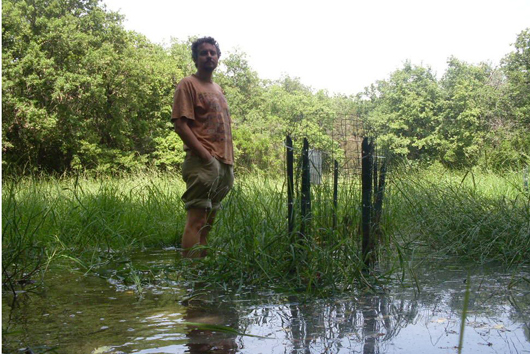
Roberto Crosti monitoring the progress of the Cyperus germplasm in the marshy glade
The authors of the report, Roberto Crosti and Giuseppe Fabrini, write: "Compared to conservation in seed bank facilities, new population establishment would have the advantage of having having a new seed set from acclimatised plants each year."
The carefully selected new site (chosen from a possible five suitable sites) was 25km from the source site and is a woodland glade with a seasonal pond - the woodland providing a biological barrier for the spread of germplasm. Seeds were sown and seedlings planted in two 75 x 150cm plots, fenced by wire mesh to prevent grazing and zoochory. The soil was cleared of vegetation to reduce competition.
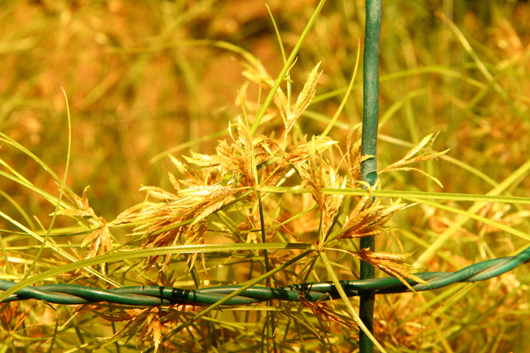
Cyperus polystachyus seedling growing behind protective fence in the translocation site
The germplasm translocation project started in June 2008 and, according to IUCN's criteria for evaluating populations monitoring should be carried out over at least 10 years or three generations. The first stage of the translocation experiment can be considered a success, as it revealed two generations of new seedlings, but worryingly the number of mature plants in September 2009 was much lower than in September 2008. Seed viability and germination rates were similar to the original source site, so it is believed that continuing the conservation effort and would likely ensure the self-sustainability of the new population.
From conservation introduction to population reinforcement
In 2007 the Tor Caldara original source site experienced a huge population decline (approximately 70% less seed in the soil seed bank) due to water capture and subsequent summer drying of a pond which used to sustain the most prolific Cyperus station. Seed harvested from the translocated population located in the Protected Area of Decima-Malafede were used to reinforce the original site with sowing and planting of germopasm, attempting to restore the original population.
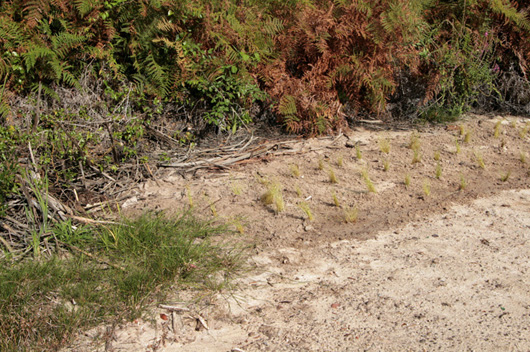
Population re-inforcement - the addition of germoplasm from the translocation site to the original population source
One of the authors, Roberto Crosti, speaks positively about the project and his concerns stem from the age-old problem of funding: "I really believe that it is one of the most pragmatic plant conservation projects in Italy. However I have to admit that not enough effort was put into ongoing care and post-translocation management in the initial technical description and schedule of the project. In fact, the response of vegetation to conservation introduction is well beyond the average time of a research project. In working with endangered species it is important to involve the local community and ensure a commitment to long-term care and monitoring."
Download the full report (pdf)
Related links:
Successful translocation of Critically Endangered Cyperus polystachyus (BGCI)
Spain: Crocus - banking the world's most expensive spice
28.07.10 by José Antonio Fernández, Crocusbank Coordinator
 Saffron is made from the dried stigmas of the Saffron flower (Crocus sativus L.), a triploid sterile plant vegetatively propagated by means of bulbs (also called corms or onions). Saffron is unique among crops - the product is the stigma and each one one weighs about 2 mg. (Read more...)
Saffron is made from the dried stigmas of the Saffron flower (Crocus sativus L.), a triploid sterile plant vegetatively propagated by means of bulbs (also called corms or onions). Saffron is unique among crops - the product is the stigma and each one one weighs about 2 mg. (Read more...)
Spain: Polygala balansae - only known European population under threat
06.05.10
 Researchers at the University of Granada (UGR) have studied the natural history and conservation status in Spain of the only known population of Polygala balansae in Europe, a thorny bush that can grow up to 1.5 metres high, and previously thought to be exclusive to Morocco.
Researchers at the University of Granada (UGR) have studied the natural history and conservation status in Spain of the only known population of Polygala balansae in Europe, a thorny bush that can grow up to 1.5 metres high, and previously thought to be exclusive to Morocco.
Saving the flora of Mediterranean islands
23.06.09
 Visitors to a Greek island in August, strolling to the beach through a parched olive grove, with only golden grasses and desiccated seed heads around their feet would find it hard to believe that only a few months earlier the ground had been covered in a carpet of wild flowers and herbs, stirred into life by the first winter rains. The countries of the Mediterranean basin share 25,000 different species of flowering plants and ferns and 60 per cent of these are found nowhere else on earth, making it one of the world’s biodiversity ‘hotspots’.
Visitors to a Greek island in August, strolling to the beach through a parched olive grove, with only golden grasses and desiccated seed heads around their feet would find it hard to believe that only a few months earlier the ground had been covered in a carpet of wild flowers and herbs, stirred into life by the first winter rains. The countries of the Mediterranean basin share 25,000 different species of flowering plants and ferns and 60 per cent of these are found nowhere else on earth, making it one of the world’s biodiversity ‘hotspots’.